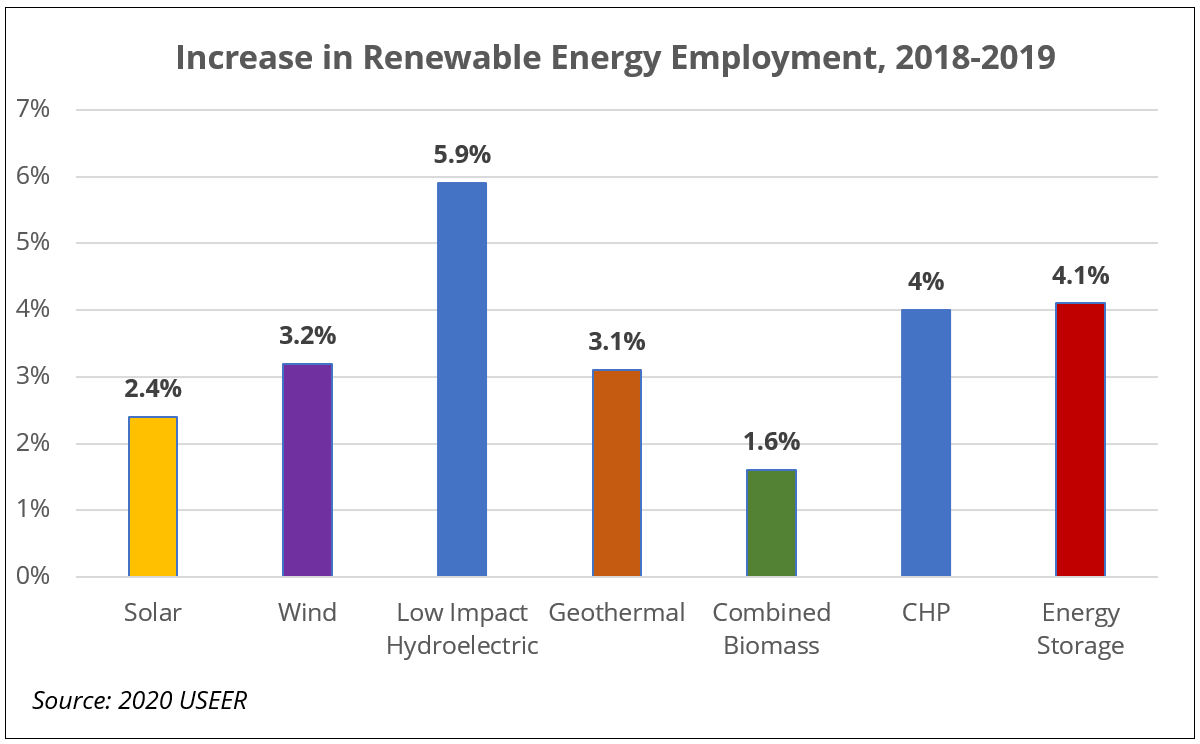COVID-19 Hinders Progress in U.S. Renewable Energy Job Growth
By: Maheen Ahmad
April 23, 2020
U.S. employment in the renewable energy sector increased in 2019 and was expected to continue growing in 2020. However, the global COVID-19 pandemic has stopped clean energy job growth in its tracks. Supply chain disruptions, social distancing measures, project delays and cancellations, and other pandemic-related factors are significantly impacting the renewable energy workforce. Strikingly, March 2020 unemployment claims effectively wiped out all renewable sector job growth from 2019 – a trend that is expected to worsen as the months progress.
Prior to COVID-19:
Renewable Energy and Energy Storage Employment Increased in 2019
According to the latest 2020 U.S. Energy and Employment Report (USEER), jobs in the solar, wind, low-impact hydroelectric, geothermal, biomass and combined heat and power (CHP) sectors all experienced positive increases in employment in 2019. In total, the renewable sector added 16,302 jobs, representing an increase of 3.2% compared to the previous year. The energy storage sector added 3,320 jobs, representing an increase of 4.1%.

Total Renewable Energy Employment in the Electric Power Sector in 2019 Was More than Twice that of Fossil Fuels
In 2019, 524,785 total renewable energy jobs made up more than half of total jobs in the Electric Power Generation sector, and more than twice the Electric Power Generation-related jobs in the oil, natural gas, and coal sectors combined. In addition, energy storage sector jobs reached 84,301 in 2019, with battery storage and pumped hydropower technologies together creating 74,452 jobs.
Renewable Energy and Energy Storage Employers Expected Continued Job Growth in 2020
USEER projected renewables would continue driving job growth in 2020. Solar, wind, and low-impact hydroelectric employers expected to increase total employment by 7.2%, 4%, and 5.9% respectively in 2020. Energy storage employers anticipated battery storage employment to grow by a total of 7.1% and pumped hydro employment to grow by a total of 1.6% over the course of this year.
Post COVID-19:
Renewable Energy Job Losses in March 2020 Alone Eliminated the Progress Made in all of 2019
As of March 2020, the U.S. renewable energy workforce experienced a decrease of 3.2%, or 16,500 job losses due to COVID-19, according to a new report of unemployment data by BW Research Partnership and a related analysis by E2. According to the analysis, an additional 4,300 grid and storage workers filed for unemployment due to project cancellations, delays and constrained financing. If the underemployed and temporarily unemployed are included, job losses would have been as high as 75,000 – representing a 14% decrease in employment in March alone.

The Renewable Energy Sector Lost Jobs at More than Triple the Rate of the Overall U.S. Economy in March 2020
According to BLS data, in March 2020, the national unemployment rate increased by 0.9% while jobs in the renewable energy sector decreased by 3.2% – more than three times the increase in the national unemployment rate.
Job Losses in the Sector Could Increase Substantially
The E2 analysis projects a continued sharp increase in unemployment filings by renewable energy workers as shelter-in-place requirements continue, which could lead to furloughs being converted to layoffs and cause restrictions in access to financing. Job losses could impact as many as half-a-million workers in the clean energy sector this summer.
Action to Stem Further Job Losses
To mitigate the impacts of COVID-19 on the renewable sector, ACORE is advocating jointly with other clean energy organizations for the prompt repair and extension of critically important clean energy tax incentives. In a letter to Congress released earlier this month, ACORE is requesting House and Senate leadership to:
- Extend placed-in-service and start construction deadlines to ensure that renewable projects can qualify for existing renewable tax credits currently at risk due to pandemic-related delays
- Establish temporary refundability of renewable energy tax credits to facilitate their monetization in the face of an impaired tax equity market
As ACORE President and CEO Gregory Wetstone recently told reporters, “In the end, we’re all in this together, and the renewable energy industry wants to be a key economic driver to help the nation through this downturn, as well as an effective climate solution over the long haul.”
Join leaders from across the clean energy sector.

What will our next 20 years look like? Here’s the truth: they’ll be better with ACORE at the forefront of energy policy.
Shannon Kellogg
Amazon Web Services (AWS)
